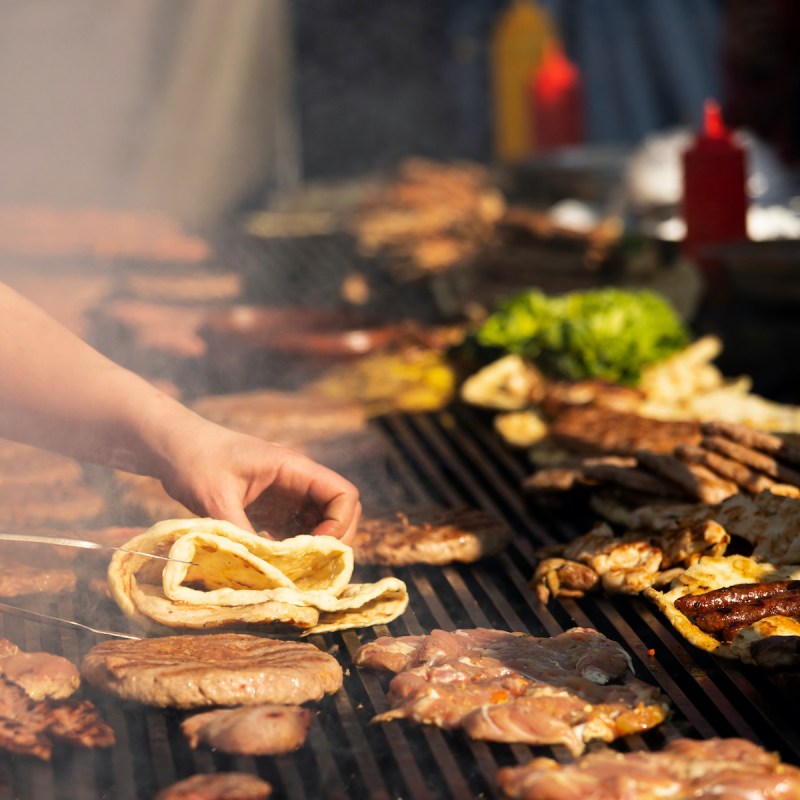
Travelers who dream of a trip to Croatia picture the rocky Adriatic beaches, the fabulous walled city of Dubrovnik, or the palm-laden islands along the coast. What they don’t often think about is the wide variety of foods found across the country, some of which is pretty dreamy in its own right.
Videos by TravelAwaits
The locals will tell you it’s hard to find a truly Croatian dish anywhere in the country because what they eat has been so influenced by the country’s neighbors. Whether it’s the Italian influences from the west, the Turkish influences from the east, the Mediterranean from the south, or the Hungarian from the north, Croatia lies at a crossroads of cuisine that cooks up a memorable mélange of flavors.
Though it’s a relatively small country, menus vary depending on just where you are. The midpoint of Croatian dining is probably found, fittingly enough, in its capital, where Croatians can dine well on a tight budget. Walking the streets of Zagreb with just a few dozen kune (the local currency) in your pocket, you’ll be able to find and enjoy any of these street foods meant to satisfy a stingy budget and a discerning palate.

Sausage Fingers That’ll Get a Grip on You
Probably one of the best-loved eating options in Croatia is the ubiquitous ćevapi (pronounced chuh-VAHP-ee). At first glance, you think it’s a cartoonishly-large hamburger. But a look under the bun tells you it’s so much more. The meat doing the work here is the humble ćevap, a minced sausage shaped like flat, little fingers. For the typical order of ćevapi, you’ll get about 10 or 12 of these tasty gems laid across a bun that’s wider than your outstretched hand. Self-respecting Croatians eat their ćevapi covered in chopped white onions — the more, the better. Though it’s served on a sort of a bun, the bread — while quite tasty — is a little too limp to pick up in its oversized form. Most choose to tear the bread into smaller pieces and wrap it around the ćevap and some onion, popping the whole assembly into their mouths for a delicious bite. Most restaurants will offer a couple of condiment choices with your ćevapi. While the mayo-based white sauce is fine, it’s a good be to opt for ajvar (pronounced EYE-var), an incredible red pepper relish of sorts that is unlike any condiment back home.
Locals typically cite a small restaurant just outside central Zagreb as the place to go for the best ćevapi. You won’t even find a website for Pečenjarnica Cvjetno (located at Cvjetna Cesta 21A). It’s not much more than a kitchen with a roofed porch attached where diners can enjoy their ćevapi alfresco. Expect to pay about 32 kuna for your ćevapi, which amounts to about $4.50 at the usual exchange rate. Unless you have a big appetite, one is probably enough for two people to share, as the portions on most Croatian dishes run on the large side.

This Ain’t Your Father’s Barbecue
Meat is king all over Croatia, and one way they love it is grilled. Grilled meats are typically translated to English on menus as “barbecue,” but don’t expect any tangy sauces or spicy rubs. Croatia grilled meat often gets its flavor from the inside, and that’s definitely true with the pljeskavica. The pronunciation of this one is a mouthful for English speakers because that “lj” is actually a different letter common to the Slavic languages but not comfortable for our tongues. Your best bet saying this one will be plea-YES-ka-vee-tsa. If you manage to get that out of your mouth, what you’ll get to put into your mouth is one of the most decadent meat dishes out there. When it arrives at your table, expect a thick, oversized ground meat patty bristling with spices and other stuffings like cheese or veggies. On top, you’ll see what looks like a golf ball-sized sphere of butter. That’s actually kajmak (pronounced KI-mahk), a combination of clotted cream, butter, and soft cheese that melts slowly across the meat, increasing the flavor.
A great place to try this dish is at Batak Grill (Tkalčićeva 70), located in the middle of Zagreb best dining and drinking spot, Tkalčićeva (pronounced tuh-KAL-chuh-chev-uh) Street. The restaurant calls it a đevrek (pronounced JEV-wreck) on its menu, a regional variant of the dish. Served a la carte, this massive meat patty is still enough for two to share. It runs 67 kuna, or about $10.

Meat Lovers Take Note
You can see that the meat’s the thing for most Croatians. And if a festival of meat is what you crave, then miješano meso (pronounced me-YUH-shah-no MAY-so), also called roštilj (ROSH-tlee), should be on your eating list. The name means “mixed meat,” and you’ll get that and more. Meant to be shared by a party of two or more, you’ll be delivered a platter covered in more meat than you can see in a neighborhood butcher shop window. A typical miješano mesa contains a generous helping of ćevapi, grilled chicken on skewers, chicken legs, some pljeskavica, some stuffed beef, and various sausages, along with onions, mushrooms, and bread. Most diners just dive right in, but you can get some condiments for this dish, too, including ajvar or kajmak.
One restaurant that offers several meat platter options worth your time is Maredo Grill (Florijana Andrašeca 14), located about a 25-minute walk from the central square (or a short taxi ride that will only cost about $4). The restaurant offers the Platter Maredo Grill in quantities it says serve either three or five people — but take those serving sizes with a grain of salt as they’ll probably go much further. You’ll pay 229 kuna for the smaller serving (about $11 per person) or reap some economies of scale by paying 339 kuna for the larger one (about $10 per person).
Back closer to the center of the city, The Ožujsko Pub Tkalča (Ulica Ivana Tkalčića 16) has a slightly different take with its Pub Plata which serves two. With it, you’ll get meatballs, chicken, ćevapi, pork spare ribs, vegetables, and potatoes, all for 170 kuna (or about $12 per person).

A Pocketful Of Taste
Though a dish not that uncommon to find around Europe and even in parts of America, the doner kebab is a quick, cheap way to get a taste of the Mediterranean Croatia-style. Local doner kebabs have a touch of extra flavor over what you’ll find in other parts of the world. Most shops offer either a mixed meat version with beef and lamb or a chicken variety. That’s pretty typical, but the difference comes with what else goes in. To get the Croatian taste, order yours with everything, which will include corn, pickles, lettuce, onions, tomatoes, and a soft cheese in the feta family. Top it off with all the sauces for some spice and sweetness.
You’ll find the doner kebab shops all over the city, but a great one to try is tiny Kebablec (Ulica Nikole Tesle 7) only a long block south of the main square. Look for the “kebab u lepinji” (basically “kebab in a bun”) and have the cook load it up with everything. The small size of the dish (easily enough to fill one person) will run 25 kuna (about $3.50) and the large about 35 kuna (about $5) if you want to split it with someone.

At Ease with Cheese
Vegetarians may have given up hope by now of finding a meal in meat-laden Croatia, but there are options a-plenty using sir (pronounced SEAR, Croatian for “cheese”). One simple delight is the burek, a rolled and coiled pastry typically filled with cream cheese-like stuffing (though meat bureks are also available). Portions tend, once again, to be large and they come cheap.
A landmark place to visit for a textbook burek is Bistro Dolac (Dolac 1), situated off the marketplace above the main square. Order the burek sa sirom (that just means “burek with cheese”) and be sure you get the rolled variety — not the triangular one — for a traditional experience. The burek will be as big as your plate and will cost you just 14 kuna (about $2). This is also a good time to mention that if you want to add a beer to your meal, you can get a burek and a brew for about $5. Beer is cheap in Croatia — cheaper than soft drinks in restaurants and stores. The local lagers are the cheapest and they’re pretty good. Beer lovers should also try the many craft brews now common across the region.

The First Cut Is The Cheapest
Finally, a word about perhaps the world’s most common street food: pizza (the word is the same in Croatian as it is in English). As close as it is to Italy, you’d expect good pizza in Croatia — and you’ll find it. Pizza “cuts” (what we call slices) are sold in shops and bakeries all over town and are a common lunch or dinner for a lot of Croatians. The pizza here has a hand-tossed crust that runs slightly on the thick side and has a rich, doughy taste like you’d find in Italy. The pizza has a good amount of mozzarella and offers a limited range of toppings compared with American pizza joints. The best around is usually the mushroom (vegetarians, take heart), though you can find sausage and other varieties, too.
The best street pizza in the middle of town comes from a tiny shop with the unlikely name of Fries Factory (Ilica 1). It has a menu that features fried chicken nuggets and shrimp, but there’s usually a line for the pizza cuts. For 13 kuna (a little less than $2), you’ll get a cut that’s one-sixth of a large pizza. One slice is enough for a typical lunch, so don’t overbuy. There’s nowhere to sit, so you’ll have to walk and eat. But Croatians aren’t bothered by this, so don’t feel like you’ll stick out. One final note about pizza in Croatia: It tends to come with less tomato sauce than Americans favor. Croatians may feel that way, too, because you may be surprised when the shop asks if you want ketchup to go with your cut. A lot of Croatians add the condiment to their pizza. It’s actually pretty good.
For more ideas and inspiration on Croatia, explore these articles:
